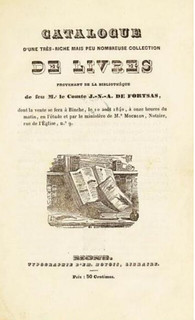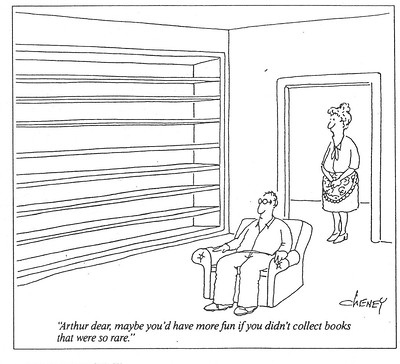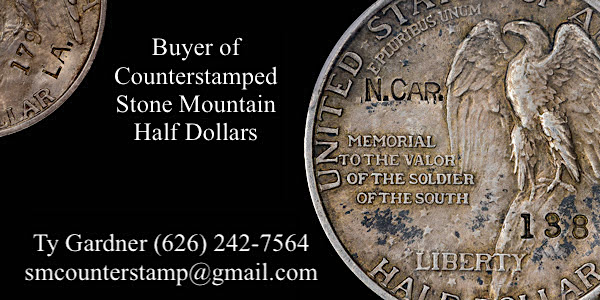
PREV ARTICLE
NEXT ARTICLE
FULL ISSUE
PREV FULL ISSUE
NUMISMATICS AND THE FORTSAS LIBRARY SALEGary Oddie recently published an article for the British Numismatic Society blog relating to books and coins. Well worth reading - there is something here for both numismatists and bibliophiles, -Editor
The following sections will present details of the sale and then three numismatic and bibliophilic connections that came to light whilst looking into this auction. This was a very select library built by the late Comte de Fortsas, for which the only criterion for inclusion was that the book was the only known example. Rare and valuable books had been disposed of during the Comte's lifetime when he learned of another specimen. Thus, the numbering in the catalogue ranged from 3 to 222, but included just 52 books. The auction was to take place at 11 o'clock on 10 August 1840, at the office of the notary Maître Moulon, 9 Rue de l'Église, Binche. Binche was a small town 10 km east of Mons and 60 km south of Brussels. The catalogue was sent to booksellers, librarians, and collectors of rare books throughout Europe along with the message ‘Jean Nepomucene Auguste Pichauld, Comte de Fortsas', had been a collector of unique books — books of which only one copy was known to exist. ‘When he had died, on September 1, 1839, he had possessed 52 such books. His heirs, not interested in collecting books, had decided to auction the collection.' A report of the auction was written up by M.L. Polain (keeper of the archives of the Province of Liége) and published on the evening of 10 August 1840 in La Politique of Liége. Having worked through a facsimile copy and a few books and articles that describe the events surrounding the auction; as well as the obvious bibliophilic interest, there were a few hidden numismatic connections that have not been highlighted before. These will be described in the sections below. Lot 23 in the catalogue appears as follows:
Which roughly translates: ‘Plate and description of the land and lordship of Rummen. Together the lineage and descendants of the lords of this land, by Dom. Cornelius Van Scheepdaal. Maastricht, Jean Nypels, 1615. A small 12mo, 88 pages, and two plates depicting the coins of Rummen, a very rare old binding in crimson satin with the arms of Rummen embroidered in silk and gold.' Rummen is a municipality in the province of Brabant. The auction report for this lot went as follows: ‘No. 23 – M. Serrure, who occupies himself with numismatic researches concerning the Lords of Rummen, did not fail to come to purchase this work. He had for a competitor M. Chalon, his rival in this kind of serious and conscientious studies. The book was briskly disputed, and the 88 pages in 12mo were finally knocked down to M. Serrure at the enormous sum of 825 francs.' At the time, a silver Franc was the equivalent of about an English silver shilling, so lot 23 sold for about £41 5s. The winner of lot 23 is likely Constant Philippe Serrure (1805-72), the son of a diamond merchant from Antwerp. He was a professor at the university of Ghent and one of the outstanding Belgian scholars of the century. He had perhaps the best private coin collection in Belgium. He was prolific in many areas and a pioneer of numismatic studies in Belgium and the Low Countries. He was the father of Constant-Antoine Serrure (1835-1898), who wrote about the Cuerdale hoard in Les Monnaies de Canute et de Sifroid, rois pirates normands et fondateurs de comité de guines (928-965), Paris 1858. His collection of ancient and Continental monnaies, medailes, jetons, et livres numismatiques, were sold in 22 sales, 1869-1877, by the obscure notary / auction house of Ed. Macau, Tournai. The grandson of C.P. Serrure was Raymond Serrure (1862-1899), member of the RNS 1891-1899, who was a coin dealer based in Paris. Please do read the complete article online - as Gary notes, "all is not as it initially appears." Meanwhile, enjoy one of my favorite cartoons about rare book collecting. -Editor
To read the complete article, see:
Wayne Homren, Editor The Numismatic Bibliomania Society is a non-profit organization promoting numismatic literature. See our web site at coinbooks.org. To submit items for publication in The E-Sylum, write to the Editor at this address: whomren@gmail.com To subscribe go to: https://my.binhost.com/lists/listinfo/esylum All Rights Reserved. NBS Home Page Contact the NBS webmaster 
|



